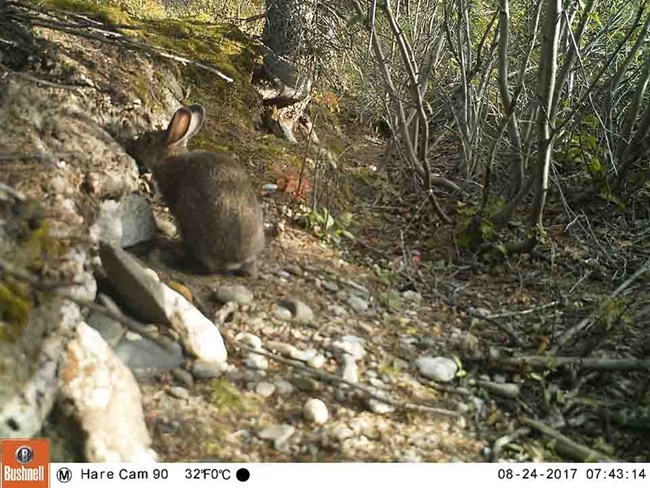Last updated: March 27, 2025
Article
Snowshoe hare use of mineral licks

Snowshoe hare distribution is generally patchy, probably due to the patchy nature of vegetation for cover and food. Many animals eat mineral soil (a behavior called geophagy) when they lack those minerals in their diets or to counter the natural toxins found in the plants they eat. We wondered if mineral licks (exposed mineral-rich soil) might also play a role in the distribution of hares. We set up cameras at mineral licks and tracked hare locations and found that hares regularly visited mineral licks within their local home ranges. The notion that mineral licks may be an important component of snowshoe hare habitat suitability is intriguing. It will warrant a bit more hopping about woods to find out.
Dining dangerously: Geophagy by snowshoe hares
Abstract
Geophagy, the consumption of mineral soil, has been reported in a wide range of species, including birds, ungulates and primates, and is particularly prevalent among generalist herbivores. Geophagic behaviors among vertebrates have been attributed primarily to the acquisition of mineral nutrients when forage plants provide insufficient supplies of these resources, well as detoxification of plant secondary metabolites. We examined geophagy by snowshoe hares near Wiseman, Alaska, using camera traps and GPS telemetry. Based on the photographic record, visitation rates ranged from 3-9 visits per 24 h, with most visits (72%) occurring at night. GPS data demonstrate that hares may include a mineral lick within their home range and that lick visitation rates by individual hares are approximately 0.5-1.0 visit/24 h. In light of experimental evidence from captive hares regarding the apparent necessity of geophagy to remain in a positive energy balance, we ponder the importance of mineral licks for the nutritional health of snowshoe hares and how the distribution of these natural features may control the local distribution of hares. We are fairly confident that the patchy distribution of hares across the landscape reflects a patchy distribution of adequate cover and food availability. However, the notion that access to mineral licks could be an important component of snowshoe hare habitat suitability is an intriguing idea that warrants a bit more hopping about in the woods.
Kielland, K., D. DiFolco, and C. Montgomerie. 2018. Dining dangerously: Geophagy by snowshoe hares. Ecology DOI:10.1002/ecy.2555
